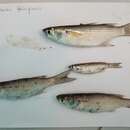Diagnostic Description
provided by Fishbase
Diagnosis: anal fin with at least 13 (usually 14) rays in total (usually III-11 in adults)(Ref. 81659), 10-11 anal soft rays (Ref. 57400). Scales on flanks cycloid; posterior end of maxilla weakly curved or almost straight; serrate, anteroventral edge of lachrymal weakly concave (Ref. 81659). 12-15 scales in an oblique, transverse series; colour of fins greyish-white; second dorsal, pectoral fins and anal fin distinctly falcate (Ref. 57400).Description: body rather deep (Ref. 81659), elongate, compressed, reaching greatest depth at level of anal-fin origin (Ref. 57400). Head broad; interorbital space almost flat (Ref. 57400). Snout blunt (Ref. 81659), broad and rounded (length = half of width)(Ref. 57400). No adipose eyelid; upper lip not ornamented (Ref. 57400). Upper lip with outer row of well spaced teeth, usually unicuspid but may include some bicuspid teeth; up to ten inner rows of small, closer-set, bicuspid teeth may be present, usually well separated from outer tooth row, but inner rows not visible in some specimens; lower lip usually without teeth, sometimes with single row of minute, ciliiform teeth (Ref. 81659). Hind end of upper jaw reaching a vertical line passing between posterior nostril and anterior eye margin; maxillary pad visible below corner of mouth when closed (Ref. 57400). Scales cycloid, except for weakly ctenoid scales on dorsal and ventral parts of caudal peduncle, and distinctly ctenoid scales on ventral parts of abdomen and thorax; in specimens >40 mm SL most scales have single groove, but some predorsal scales may have 2 small grooves; 35-40 (usually 36-37) scales in longitudinal series (excluding scales on caudal fin base); 11.5-13.5 scale rows between pelvic and first dorsal fins; second dorsal fin with 10 (rarely 9) segmented rays; anal fin with 3 spines and 11 (rarely 10 or 12) segmented rays in adults (1st spine very short and usually hidden by overlying scales); usually 2 spines and 12 segmented rays in juveniles
Migration
provided by Fishbase
Catadromous. Migrating from freshwater to the sea to spawn, e.g., European eels. Subdivision of diadromous. Migrations should be cyclical and predictable and cover more than 100 km.
Morphology
provided by Fishbase
Anal spines: 3; Analsoft rays: 10 - 12
Trophic Strategy
provided by Fishbase
Inhabits coastal marine and brackish waters (Ref. 2683) as well as rivers (Ref. 7399). Feeds on plankton and detritus (Ref. 28587). Maximum weight in Volta estuary is 262 g and 205 g in Pra estuary, Ghana (Ref. 55664).
Biology
provided by Fishbase
Euryhaline, tolerating conditions varying from hypersaline to freshwater; favours sandy or muddy substrates (Ref. 81659). Very common in coastal lagoons and estuaries (Ref. 2683, 57400, 81659). Also caught in hypersaline environments (Ref. 57400) and freshwaters (Ref. 7399, 57400, 81659) several kilometres upstream in rivers (Ref. 81659). Feed on plankton and detritus (Ref. 28587). Oviparous, eggs are pelagic and non-adhesive (Ref. 205). Spawning may occur in lagoons or in the sea (Ref. 81659). Possibly reaches up to 500mm FL (Ref. 57400, 81659).
Sicklefin mullet: Brief Summary
provided by wikipedia EN
The sicklefin mullet (Neochelon falcipinnis) is a species of ray-finned fish, a grey mullet from the family Mugilidae which is found in the eastern Atlantic Ocean of the coasts of western Africa. It is the only species in the monospecific genus Neochelon.
- license
- cc-by-sa-3.0
- copyright
- Wikipedia authors and editors

